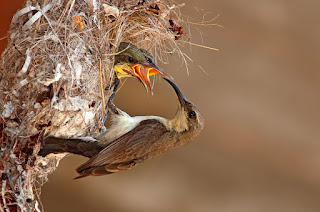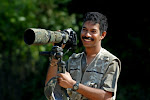What’s your “Focus” in Wildlife Photography? Self Satisfaction or just “likes”
Recently I was doing nature photography trail in Maharashtra Nature Park, Mumbai which is a cultivated city garden developed on the old dumping yard. I saw one photographer spraying water from spray gun on butterflies, bugs and other insects to get the dew drop effect. I found it very unnatural and unethical. Being a macro photographer I have seen many foreign photographers regularly refrigerate their butterflies, insects and spiders before their shoot. Here are few quotes from them –
“Insects are cold-blooded, so cooling them off for a few minutes in the refrigerator will slow them down and make them more relaxed subjects”
“Flies are easiest to capture early in the morning while they are still half asleep and cold.”
“I put the butterflies in the refrigerator to slow them down. Some of my best photos were soon after they were released and in a quiet cool mood. I can get closer.”
“By refrigerating a flying insect for 20 minutes prior to shooting, I can usually get 2-3 minutes of shooting before the insect will exhibit signs that it is considering flight. I then recapture and stuff it back in the fridge for another few minutes.”
Do you think this is right and ethical just to get a good shot of spider or butterfly? I have spent hours and hours running after butterflies or other insect to get a descent quality photo. Many a times they simply don’t pose or fly high and run away without giving a single shot even a record shot also. I personally feel that a good nature / wildlife photographer who manages the shot with the available light and environment conditions as it is and make a best photo out of it. But these days many photographer’s managed everything just like studio setup with props and even rains also.
Few years back in the 2011 National Geographic contest winner, whose image of a dragonfly in a supposed rainstorm won him the grand prize in the nature category. In his original photo submission, he claimed he was caught in a sudden downpour when he happened upon the dragonfly. Only after winning the grand prize did the “truth” shift. Careful analysis of several other similar photographs from “winner” revealed something fishy about the way the “rain” was hitting the insect. “winner” later admitted that his friend sprayed water on the dragonfly to get the shot. He claimed that the original caption he submitted alongside the photograph had been manipulated for added effect. Regardless of the truth, National Geographic angered nature photographers across the globe when it stood by its decision to award “winner” the grand prize that year.
Photographs of Dancing frog or Dancing Geckos by same photographer gone viral on internet few years back. These photos won many international photography contests and been published in media. The photographer claimed these photos are captured naturally but that's a far-fetched reality. A nature enthusiast can easily tell that these animals are staged and posed, some animals are suspected to be abused. When I look at these photos, i can only say I am really amused. The frogs or the geckos were pets but were managed by the wire or thread which was removed in post processing later.
As per me this is not at all acceptable and I feel we macro photographers (if those are really nature lovers) should follow some discipline while shooting in our forests.
Many times we observe a mating pair of butterflies or beetles, try to approach them very carefully and slowly. Do not try to bump on them. They might startle and release the mate instantly. Similarly in the case of some insect or spider is caught some prey and eating the prey. They have spent tremendous amount of energy as well as time to get the prey, our sudden movements might startle them and they try to drop the prey and run or fly off. Many times we might not get a perfect angle or eye-to-eye contact or there might be some disturbing twig in between, but try to wait patiently to get perfect angle and not to try to touch the insect. Some photographers choose to create artificial perches to make the photo beautiful. I have seen photograph of Hump nosed Pit Viper which is totally ground dwelling species, but the photographer kept the specimen on the tree trunk just like Bamboo Pit Viper. Many times I have seen people collecting specimen, bringing back to home or other closed area to do the photography. If you are not doing any scientific research and doing photography just as a hobby then this should be certainly avoided. Not only collecting but you should avoid touching the subject directly… many of us are very new in this filed and may not know about the species and their behavior. Either it may stressed out the specimen and other way if it is venomous or poisonous or may be giving itchy feeling to skin then it might be harmful for us also. Do not pluck any leaf though it is obstacle in your photo. It might be harmful for the insect or its nest which you keep open to their predators. Try to reduce footing on leaves / grass or shrubs as there might be many insect homes around them. OF course this seems very idealistic but then at least we can try to reduce harm to nature / habitat.
This is about the macro wildlife photography but what about the Bird or Mammal photography ?
We all love to go in big forests / sanctuaries / national parks. As our India is pride for its Big Cats like Asiatic Lion, Royal Bengal Tiger, Leopard and Snow Leopard, we often visits to photograph these majestic beauties in various forests. Now today in every Tiger Reserve there are boom of so called nature photographers and everybody wants the BEST shot and that too from very close distance. I have witnessed even people having cell phones wants to capture best shots and fighting for the best place to stand there in front of Tigers. But when we go in big forests then we should follow some rules which are now internationally known as ethics of wildlife photography.
View wildlife from a safe distance. Trust your camera zoom lenses, they are quite powerful and can capture wildlife from distance. We further have option to crop the subject while post processing. Never force an action. If you stay there for some time you will certainly get good action. And it is not required that you will get always “action” shots. Never come between a parent and its offspring. Mothers are always extra cautious so let them go as they wish. Never encroach on nests or dens as certain species will abandon their young. Internationally bird photography is banned and you cannot put those photos for competitions as well as photography exhibitions. Few years back one crazy nature lover (??) cum photographer promoted nest photography tours in Tadoba National Park. The photographer spotted few nesting spots near the buffer zone of Tadoba forest and he started inviting photographers for the bird nest photography claiming the bird species. Soon it was published in local newspapers and then the matter was settled down.
Few years back when Bharatpur was in full bloom, many photographers hired guides or cycle-rickshaw drivers specifically to locate the Sarus Crane’s nest and its hatchlings. After getting the tip from local guide the photographer’s set up their entire equipment very near to the nest and take close ups. Even there are few photos of the photographer’s taking macro images of the eggs / newly hatched chicks when the parents went for food. There was news that the Jackals were specifically fed meat pieces to get fight sequence amongst the jackals or meat thrown in air and they were capturing those in air. Recently there were several news about the Bangalore based photographers who are specialized in Bird’s of Prey photography especially with the snakes or rat kills. It was claimed that all the snakes were captured and kept as a bait for raptors. After reading such news and seeing the photo of the same it feels really bad. Frankly I have also used fruits baits for butterfly photography for few species which attracts only on rotten fruits. But I will not dare to keep the live or specifically half dead snakes as bait for raptors.
Just like a good citizen and real nature lover think twice before shoot such unethical clicks in nature. Also when you are on field trip in a group let the person who finds the object, allow him to shoot first. Do not try to go very near to object to get 1:1 macro. Try to shoot some record shots from behind. Let others also get few shots and then you can slowly move towards the object. Also do not try to do experiments there when other fellow photographers are waiting for their turn. I have observed several time that when someone is shooting others go opposite and try to shoot but then obviously the photographer getting the subject with “you” as a background. If you are not part of the group then ask permission politely though its not that group’s personal property but they have done efforts and have skills to find that subject in nature. I am sure if we follow some basic rules and simple ethics, our photography will give smiles to the thousand viewers and that will certainly more great and joyful than 1000s likes on Facebook or Instagram.
Yuwaraj Gurjar
www.yuwarajgurjar.com








Excellent write up!! Absolute agree with you and really hope people will follow :)
ReplyDeleteExtremely well-written sir.
ReplyDeleteExtremely well-written sir.
ReplyDeleteExcellent sir
ReplyDeleteI gothrough your whole article. This one of the best article I ever had seen. Thank you for sharing.
ReplyDeleteProfessional Photography